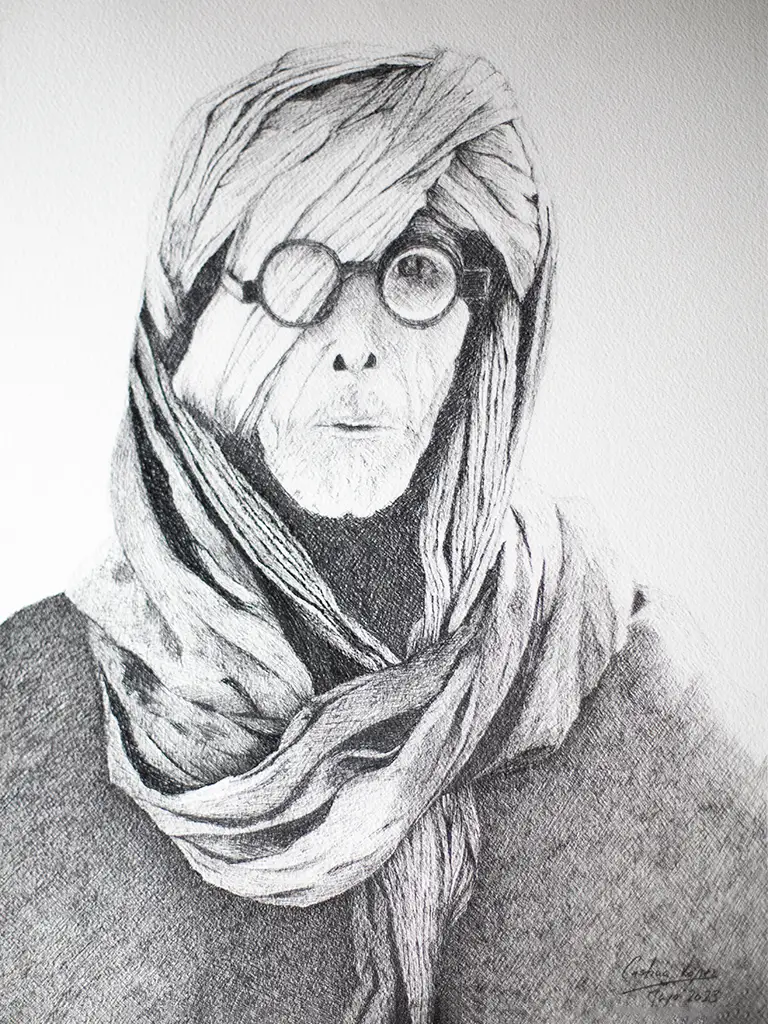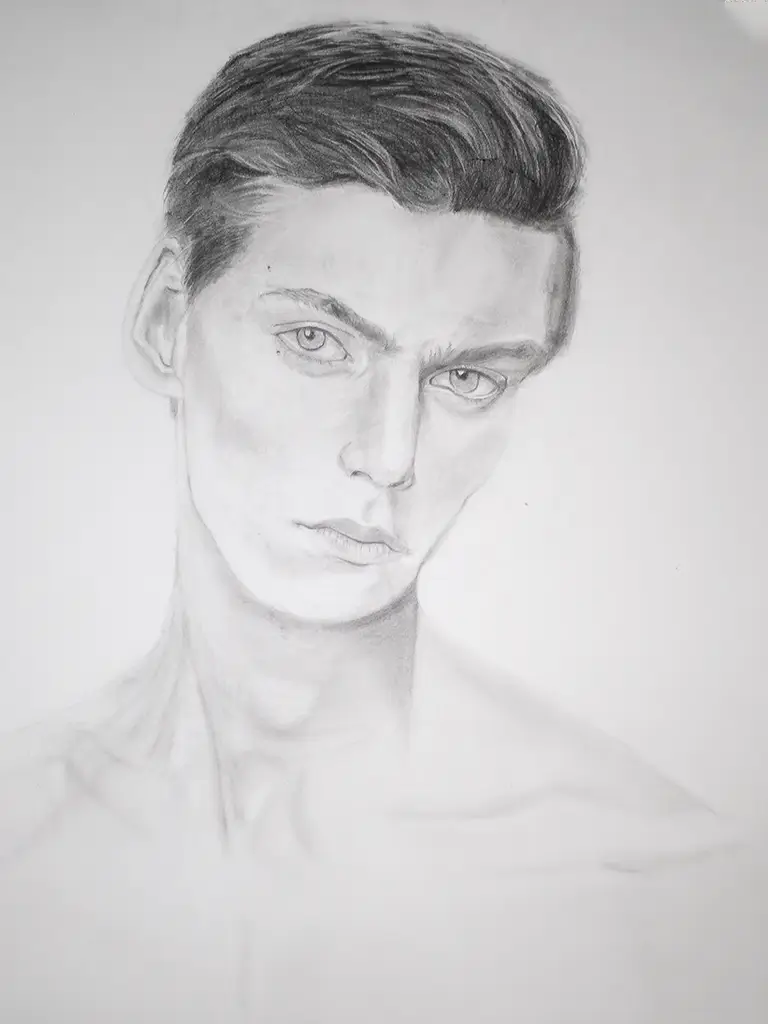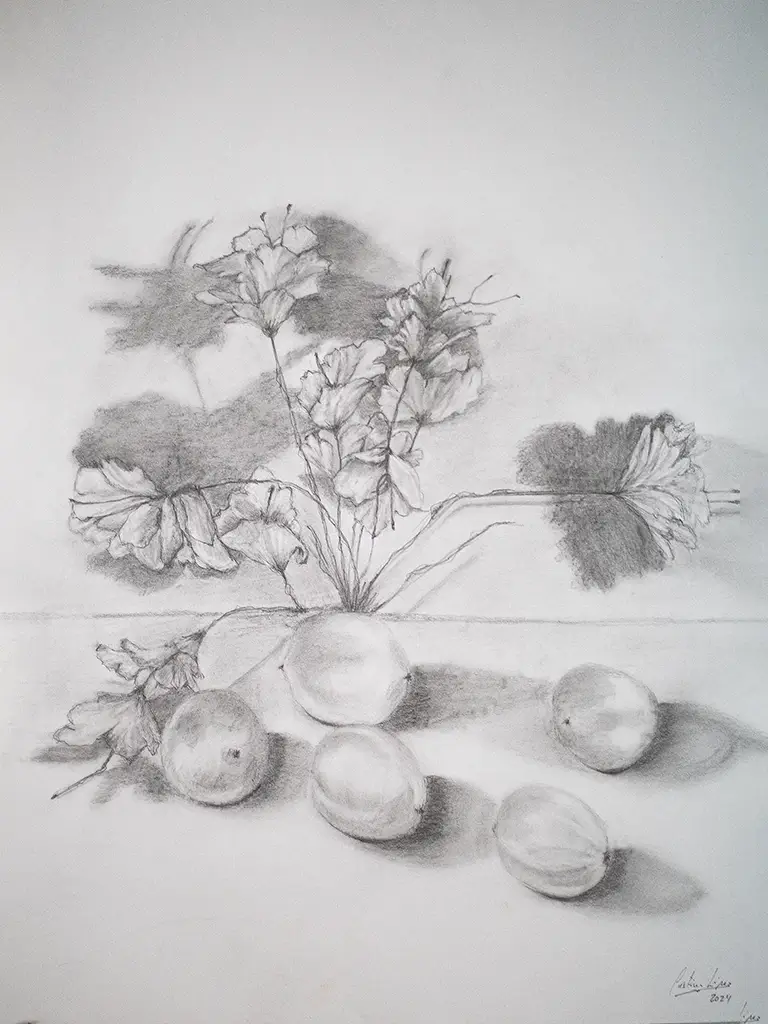Unknown III

This portrait, painted with marker and pencil – and in some strokes, with biros – depicts the face of an older man wearing glasses and a turban, enveloped in a serene, almost meditative expression. The work, in black and white, renounces colour to focus on the essential: the time inscribed in the folds of the face, the depth of the gaze, the texture of a life.
The technique combines fine lines with areas of shadow constructed from crossed layers. The pen gives a particular density, almost metallic, while the felt-tip pen defines contours and gives weight to the dark areas. The pencil softens, connects, breathes between contrasts. Together, these tools construct not only a figure, but a presence.
The turban, more than an accessory, is a symbol of identity, wisdom and tradition. The glasses frame eyes that look not directly, but inwards, as if they were remembering rather than observing. There is no drama, only dignity.
This drawing is not meant to idealise, but to honour. It is a portrait of humanity, of memory, of roots. Of someone who, although we do not know by name, we feel close to, as if their story – silent, drawn line by line – also spoke a little of our own.
Unknown II

This work portrays a young woman wrapped in a white shirt, a simple garment that nevertheless becomes the perfect vehicle for exploring light, transparency and the intimacy of the instant. The technique combines soft pastels and coloured pencil, a mixture that allows for both precise strokes and free gesture, creating a balance between control and spontaneity.
The pastels provide a velvety, almost floating texture that adheres delicately to the paper. The skin tones build layer by layer, revealing the pinks, ochres and lilacs that lie beneath the surface. Coloured pencil is used to accentuate the subtle contours, give definition to the eye and suggest the folds of the shirt, without harshening the overall softness of the drawing.
What lies behind this portrait is not just a female figure, but a restrained atmosphere. She does not look directly, she does not pose, she simply is. The white shirt is not just clothing, it is a symbol of vulnerability, of emotional cleansing, of an intimate moment in which the person is shown without armour.
More than a figure study, this drawing seeks to capture a suspended emotion, as if time has stopped for a second before something changes.
Unknown I

This drawing, made with charcoal on paper, captures the face of a young man whose expression is a mixture of strength and softness. Charcoal, with its ability to create intense contrasts and emotionally charged strokes, allows us to explore both the texture of the skin and the depth of the gaze. Unlike graphite, charcoal does not seek surgical precision, but rather an atmosphere, a feeling that breathes between line and shadow.
The process began with loose, gestural strokes, letting the face emerge little by little from the white void. The technique plays with the ephemeral: smudges, blurring with the fingers, lines that are almost completely erased and others that cling to the paper. Each layer is a decision between what is revealed and what is insinuated.
The figure depicted, with subtly effeminate features, does not respond to a specific ideal, but seeks to question it. What defines masculinity? Where does femininity begin? This face inhabits that in-between space, that terrain where labels are diluted. There is no fixed narrative; only a silent presence that invites us to look without prejudice.
Even the imperfections—accidental smears, fingerprints caught in the medium—are part of the story. They ground the portrait in reality, reminding us that this is not a polished icon, but a human being, captured in a moment of becoming. The drawing resists conclusion. It asks questions rather than offering answers, and in doing so, becomes a mirror for the viewer.
It is not just a portrait. It is an exploration of identity, of presence, of the fragile line between being seen and being understood.
Study of lemons in charcoal

This study of lemons in charcoal captures with sober intensity the stillness and complexity of the everyday. The painting presents three lemons arranged on a rough surface, probably wood, where the texture is insinuated with dense, dark strokes. There is no colour, only shadows. The absence of vibrant yellow forces the viewer to look beyond the obvious: to observe the wrinkles in the skin, the subtle weight of each fruit, the way the light hits the outline and dissolves into the background, almost as if the lemons were emerging from a silent penumbra.
The process of creation was entirely analogue: it began with prolonged observation in natural afternoon light, in a small studio with west-facing windows. The lemons were placed unpretentiously, without any studied composition, simply as they had been left after purchase at the market. What began as a technical exercise in chiaroscuro became a graphic meditation on time and imperfection.
Inspiration was born out of a need to pause. The artist, overwhelmed by the constant rhythm of digital colour and the immediacy of modernity, sought refuge in the elemental: paper, charcoal and fruit. There is something in lemons that refers to the ephemeral – their aroma, their acidity, their ripening process – and that transience is contrasted here with the permanence of the graphite on the paper. In each stroke we perceive the intention of capturing not only a form, but a sensation: the light weight of the simple that nevertheless persists in the visual memory.